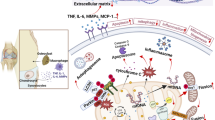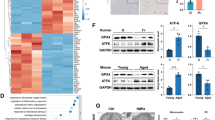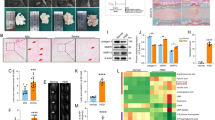Abstract
Our aim was to improve the survival and reduce the apoptosis of chondrocytes derived from mesenchymal stem cells from Wharton’s jelly of human umbilical cord (WJMSCs) by Lovastatin supplementation under hydrogen-peroxide-induced injury conditions to simulate the osteoarthritic micro-environment. Chondrocytes were differentiated in vitro from WJMSCs. The cultured WJMSCs expressed CD90 (84.07%), CD105 (80.84%), OCT4 (26.90%), CD45 (0.42%) and CD34 (0.48%) as determined by flow cytometry. Increased aggregation of proteoglycans observed by Safranin-O staining accompanied by increased expression of COL2A1, ACAN, SOX9 and BGN shown by immunocytochemistry and reverse transcription with the polymerase chain reaction (PCR) confirmed the chondrogenic differentiation of the WJMSCs. The in vitro differentiated chondrocytes were subjected to oxidative stress by exposure to 200 μM hydrogen peroxide, either in the presence or absence of Lovastatin (2 μM) for 5 h. Lovastatin treatment resulted in decreased apoptosis, senescence and LDH release and in increased viability and proliferation of WJMSC-derived chondrocytes. Real time PCR analysis showed markedly up-regulated expression of prosurvival, proliferation and chondrogenic genes (BCL2L1, BCL2, AKT, PCNA, COL2A1, ACAN, SOX9 and BGN) and significantly down-regulated expression of pro-apoptotic genes (BAX, FADD) in the Lovastatin-treated group in comparison with injured cells. The reduced expression of VEGF and p53 as determined by enzyme-linked immunosorbent assay and PCR suggests the suitability of the use of Lovastatin in adjunct to WJMSC-derived chondrocytes for the treatment of osteoarthritis. We conclude that Lovastatin protects WJMSC-derived chondrocytes from hydrogen-peroxide-induced in vitro injury.






Similar content being viewed by others
References
Aini H, Ochi H, Iwata M, Okawa A, Koga D, Okazaki M, Sano A, Asou Y (2012) Procyanidin b3 prevents articular cartilage degeneration and heterotopic cartilage formation in a mouse surgical osteoarthritis model. PLoS One 7:e37728
Akiyama H, Chaboissier MC, Martin JF, Schedl A, de Crombrugghe B (2002) The transcription factor Sox9 has essential roles in successive steps of the chondrocyte differentiation pathway and is required for expression of Sox5 and Sox6. Genes Dev 16:2813–2828
Chen WH, Lai MT, Wu AT, Wu CC, Gelovani JG, Lin CT, Hung SC, Chiu WT, Deng WP (2009) In vitro stage-specific chondrogenesis of mesenchymal stem cells committed to chondrocytes. Arthritis Rheum 60:450–459
Dickhut A, Pelttari K, Janicki P, Wagner W, Eckstein V, Egermann M, Richter W (2009) Calcification or dedifferentiation: requirement to lock mesenchymal stem cells in a desired differentiation stage. J Cell Physiol 219:219–226
Djouad F, Delorme B, Maurice M, Bony C, Apparailly F, Louis-Plence P, Canovas F, Charbord P, Noël D, Jorgensen C (2007) Microenvironmental changes during differentiation of mesenchymal stem cells towards chondrocytes. Arthritis Res Ther 9:R33
Dolga AM, Nijholt IM, Ostroveanu A, Ten Bosch Q, Luiten PG, Eisel UL (2008) Lovastatin induces neuroprotection through tumor necrosis factor receptor 2 signaling pathways. J Alzheimers Dis 13:111–122
Facchini A, Stanic I, Cetrullo S, Borzi RM, Filardo G, Flamigni F (2011) Sulforaphane protects human chondrocytes against cell death induced by various stimuli. J Cell Physiol 226:1771–1779
Fay J, Varoga D, Wruck CJ, Kurz B, Goldring MB, Pufe T (2006) Reactive oxygen species induce expression of vascular endothelial growth factor in chondrocytes and human articular cartilage explants. Arthritis Res Ther 8:R189
Fong CY, Subramanian A, Gauthaman K, Venugopal J, Biswas A, Ramakrishna S, Bongso A (2012) Human umbilical cord Wharton’s jelly stem cells undergo enhanced chondrogenic differentiation when grown on nanofibrous scaffolds and in a sequential two-stage culture medium environment. Stem Cells Rev 8:195–209
Golub EE, Boesze-Battaglia K (2007) The role of alkaline phosphatase in mineralization. Curr Opin Orthop 18:444–448
Han I, Park HJ, Seong SC, Lee S, Kim IG, Lee MC (2011) Role of transglutaminase 2 in apoptosis induced by hydrogen peroxide in human chondrocytes. J Orthop Res 29:252–257
Herrero-Martin G, López-Rivas A (2008) Statins activate a mitochondria-operated pathway of apoptosis in breast tumor cells by a mechanism regulated by ErbB2 and dependent on the prenylation of proteins. FEBS Lett 582:2589–2594
Ho WP, Chan WP, Hsieh MS, Chen RM (2009) Runx2-mediated bcl-2 gene expression contributes to nitric oxide protection against hydrogen peroxide-induced osteoblast apoptosis. J Cell Biochem 108:1084–1093
Khan M, Akhtar S, Mohsin S, Khan SN, Riazuddin S (2011) Growth factor preconditioning increases the function of diabetes-impaired mesenchymal stem cells. Stem Cells Dev 20:67–75
Kishimoto H, Akagi M, Zushi S, Teramura T, Onodera Y, Sawamura T, Hamanishi C (2010) Induction of hypertrophic chondrocyte-like phenotypes by oxidized LDL in cultured bovine articular chondrocytes through increase in oxidative stress. Osteoarthr Cartil 18:1284–1290
Lee JH, Jin Y, He G, Zeng SX, Wang V, Wahl GM, Lu H (2012) Hypoxia activates tumor suppressor p53 by inducing ATR-Chk1 kinase cascade-mediated phosphorylation and consequent 14-3-3γ inactivation of MDMX protein. J Biol Chem 287:20898-20903
Li J, Wang JJ, Yu Q, Chen K, Mahadev K, Zhang SX (2010a) Inhibition of reactive oxygen species by Lovastatin downregulates vascular endothelial growth factor expression and ameliorates blood-retinal barrier breakdown in db/db mice: role of NADPH oxidase 4. Diabetes 59:1528–1538
Li T, Zhang X, Zhao X (2010b) Powerful protective effects of gallic acid and teapolyphenols on human hepatocytes injury induced by hydrogen peroxide or carbon tetrachloride in vitro. J Med Plants Res 4:247–254
Ma FX, Chen F, Ren Q, Han ZC (2009) Lovastatin restores the function of endothelial progenitor cells damaged by oxLDL. Acta Pharmacol Sin 30:545–552
Mohsin S, Shams S, Ali Nasir G, Khan M, Javaid Awan S, Khan SN, Riazuddin S (2011) Enhanced hepatic differentiation of mesenchymal stem cells after pretreatment with injured liver tissue. Differentiation 81:42–48
Nekanti U, Dastidar S, Venugopal P, Totey S, Ta M (2010) Increased proliferation and analysis of differential gene expression in human Wharton’s jelly-derived mesenchymal stromal cells under hypoxia. Int J Biol Sci 6:499–512
Nubel T, Damrot J, Roos WP, Kaina B, Frtz G (2006) Lovastatin protects human endothelial cells from killing by ionizing radiation without impairing induction and repair of DNA double-strand breaks. Clin Cancer Res 12:933–939
Pereira WC, Khushnooma I, Madkaikar M, Ghosh K (2008) Reproducible methodology for the isolation of mesenchymal stem cells from human umbilical cord and its potential for cardiomyocyte generation. J Tissue Eng Regen Med 2:394–399
Pfander D, Körtje D, Zimmermann R, Weseloh G, Kirsch T, Gesslein M, Cramer T, Swoboda B (2001) Vascular endothelial growth factor in articular cartilage of healthy and osteoarthritic human knee joints. Ann Rheum Dis 60:1070–1073
Xu R, Chen J, Cong X, Hu S, Chen X (2008) Lovastatin protects mesenchymal stem cells against hypoxia- and serum deprivation-induced apoptosis by activation of PI3K/Akt and ERK1/2. J Cell Biochem 103:256–269
Yoda M, Sakai T, Mitsuyama H, Hiraiwa H, Ishiguro N (2011) Geranylgeranylacetone suppresses hydrogen peroxide-induced apoptosis of osteoarthritic chondrocytes. J Orthop Sci 16:791–798
Yudoh K, Karasawa R (2010) Statin prevents chondrocyte aging and degeneration of articular cartilage in osteoarthritis (OA). Aging 2:990–998
Zhao TT, Le Francois BG, Goss G, Ding K, Bradbury PA, Dimitroulakos J (2010) Lovastatin inhibits EGFR dimerization and AKT activation in squamous cell carcinoma cells: potential regulation by targeting rho proteins. Oncogene 29:4682–4692
Author information
Authors and Affiliations
Corresponding author
Additional information
Nadia Wajid and Azra Mehmood contributed equally to this work.
This work was supported by research grants from Higher Education Commission (HEC) of Pakistan.
The authors declare no conflicts of interest.
Electronic supplementary material
Below is the link to the electronic supplementary material.
Table S1
List of antibodies used (JPEG 44 kb)
High Resolution Image 1
(TIFF 4756 kb)
Fig. S1
Optimization of hydrogen-peroxide-induced in vitro injury conditions in WJMSC-derived chondrocytes. a Phase contrast images of WJMSC-derived chondrocytes showing the morphology of the cells subjected to 200 μM hydrogen peroxide for various time periods, i.e., C (0 h), H1 (1 h), H2.5 (2.5 h) and H5 (5 h). 200x, Bars ∼100 μm. b Trypan blue exclusion assay with maximum non-viable cells in the H5 group. c Gel bands for RT-PCR analysis of mRNA of FADD, BAX and BCL2L1. d Quantitative expression of FADD, BAX and BCL2L1 in various groups as determined by Image J software. *Significant difference between control (C) and 5-h (H5) groups (P<0.05). Data are expressed as means ± SD (JPEG 82 kb)
High Resolution Image 2
(TIFF 6740 kb)
Fig. S2
Dose optimization of Lovastatin during hydrogen-peroxide-induced in vitro injury in WJMSC-derived chondrocytes. a Phase contrast images of WJMSC-derived chondrocytes showing the morphology of the cells kept as C (control), H (subjected to 200 μM hydrogen peroxide alone), L0.5 (subjected to 0.5 μM Lovastatin together with 200 μM hydrogen peroxide for 5 h), L1 (1 μM Lovastatin together with 200 μM hydrogen peroxide for 5 h), or L2 (2 μM Lovastatin together with 200 μM hydrogen peroxide for 5 h). 200x, Bars ∼100 μm. b Trypan blue exclusion assay with maximum viable cells in the L2 group (JPEG 60 kb)
High Resolution Image 3
(TIFF 5050 kb)
Rights and permissions
About this article
Cite this article
Wajid, N., Mehmood, A., Bhatti, FuR. et al. Lovastatin protects chondrocytes derived from Wharton’s jelly of human cord against hydrogen-peroxide-induced in vitro injury. Cell Tissue Res 351, 433–443 (2013). https://doi.org/10.1007/s00441-012-1540-3
Received:
Accepted:
Published:
Issue Date:
DOI: https://doi.org/10.1007/s00441-012-1540-3




